
Deschampsia antarctica, the Antarctic hair grass, is one of two flowering plants native to Antarctica, the other being Colobanthus quitensis.
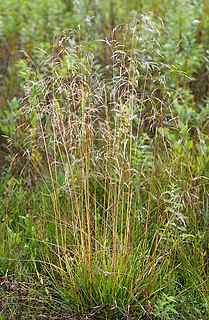
Deschampsia cespitosa, commonly known as tufted hairgrass or tussock grass, is a perennial tufted plant in the grass family Poaceae. Distribution of this species is widespread including the eastern and western coasts of North America, parts of South America, Eurasia and Australia.

Deschampsia is a genus of plants in the grass family, commonly known as hair grass or tussock grass. The genus is widespread across many countries.
Hair grass is a common name for several plants and can refer to:

Festuca rubra is a species of grass known by the common name red fescue or creeping red fescue. It is widespread across much of the Northern Hemisphere and can tolerate many habitats and climates. It is best adapted to well-drained soils in cool, temperate climates; it prefers shadier areas and is often planted for its shade tolerance. Wild animals browse it, but it has not been important for domestic forage due to low productivity and palatability. It is also an ornamental plant for gardens.

Danthonia californica is a species of grass known by the common name California oatgrass. This plant is native to two separate regions of the Americas, western North America from California to Saskatchewan, and Chile.

Festuca idahoensis is a species of grass known by the common names Idaho fescue and blue bunchgrass. It is native to western North America, where it is widespread and common. It can be found in many ecosystems, from shady forests to open plains grasslands.

Aira praecox is a species of grass known by several common names, including early hair-grass, yellow hairgrass and spike hairgrass. It is native to Europe, where it is found in dry, sandy places, on rocky outcrops, and in heath grassland. It also grows in North America as an introduced species, where it can be found on the east and west coasts in sandy or rocky areas, such as beaches and roadsides. This is a tuft-forming annual grass growing up to about 25 centimeters in maximum height. The thin, narrow leaves are located at the base of the stem, and are typically 0.3–2 millimeters wide. It bears very small inflorescences of purple-tinted green bisexual spikelets.
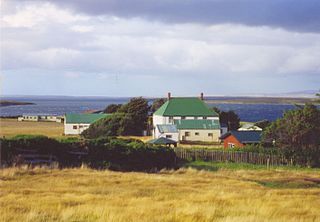
Tussock grasses or bunch grasses are a group of grass species in the family Poaceae. They usually grow as singular plants in clumps, tufts, hummocks, or bunches, rather than forming a sod or lawn, in meadows, grasslands, and prairies. As perennial plants, most species live more than one season. Tussock grasses are often found as forage in pastures and ornamental grasses in gardens.

Deschampsia elongata is a species of grass known by the common name slender hairgrass.

Panicum dichotomiflorum, known by the common names fall panicgrass, autumn millet, and fall panicum is a species of Poaceae "true grass". It is native to much of the eastern United States and parts of Canada, and it can be found in the Western United States through California. It may be an introduced species in some western climates. It grows in many types of habitat, including disturbed areas and chaparral habitats.

Melinis repens is a species of grass known by the common names rose Natal grass, Natal red top, or simply Natal grass. It is native to southern Africa and an introduced species, often considered a noxious weed, on other continents such as North America and Australia. It is an annual or perennial grass, growing up to a meter tall. Its growth rate is dependent on temperature. The inflorescence is an open array of branches bearing spikelets densely coated in silky white or pink hairs.
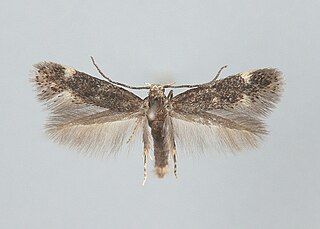
Elachista humilis is a moth of the family Elachistidae found in most of Europe.

Puccinellia simplex is a species of grass known by the common names California alkaligrass and western alkali grass. It is native to California, where it grows in mineral springs and other moist habitat with saline soils in the Central Valley, Mojave Desert, and other areas. It is also known from Utah, but occurrences there are probably introduced. This annual grass grows up to about 25 centimeters tall. The inflorescence is generally a linear structure with parallel branches bearing small spikelets.
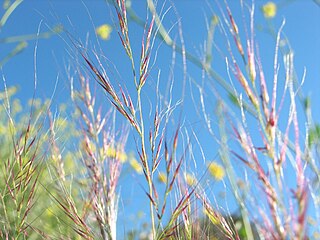
Vulpia microstachys is a species of grass known by the common names small fescue and small sixweeks grass. It is native to western North America from British Columbia to Colorado and New Mexico to Baja California, where it grows in many types of open habitat, including grasslands. It is dominant on some grasslands of California, and it was probably an abundant native grass before the habitat was altered by invasive non-native grasses. It occurs on serpentine soils with associates such as serpentine reedgrass. It is also known from parts of South America. It is an annual grass producing one stem or a clump of several stems growing up to 75 centimeters tall. The inflorescence has several open branches bearing clusters of purple-tinged spikelets. The spikelet has one to six flowers. The grass is usually cleistogamous, its flowers fertilizing themselves.
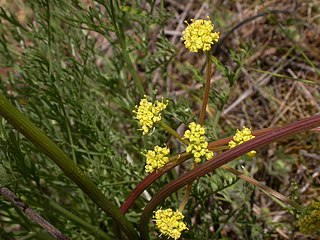
Lomatium cookii is a rare species of flowering plant in the carrot family known by the common names Cook's lomatium and agate desertparsley. It is endemic to Oregon in the United States, where it grows in only two valleys. It is a federally listed endangered species.
Achnatherum richardsonii is a species of grass known by the common names Richardson's needlegrass, spreading needlegrass, and Canada mountain-ricegrass. It is native to northwestern North America, where it is distributed from Alaska and Yukon through the western Canadian provinces south to Colorado.

Pleuropogon oregonus is a species of grass known by the common name Oregon semaphoregrass.
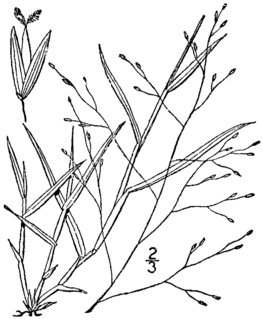
Digitaria cognata is a species of grass known by the common names fall witchgrass, Carolina crabgrass, and mountain hairgrass.

















